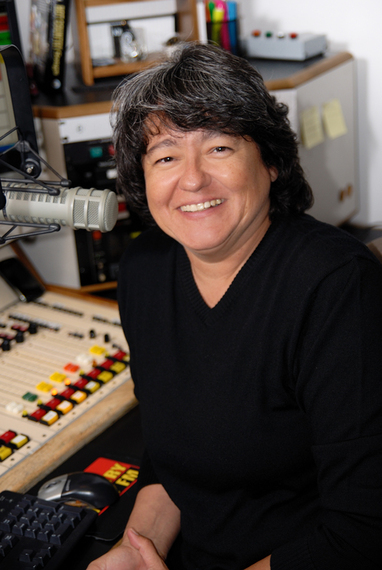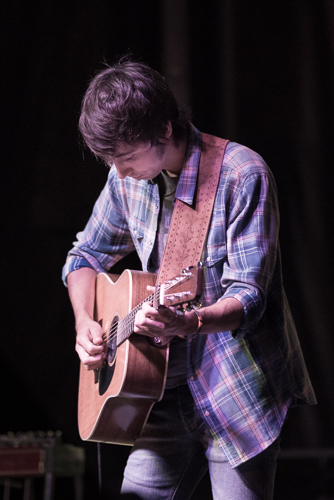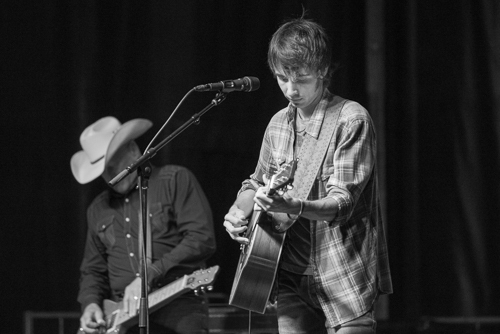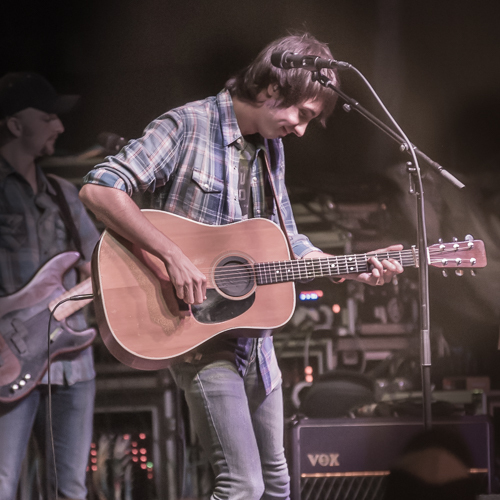So how does a song even get on the radio anyway? How does it happen, that great moment when you're listening to the radio and you hear that song you like?
There could probably be a lot of stories about how that happens, because a lot of songs get played on a lot of radio stations. But even when you find out how just one song got on one radio station, it turns out that it's more than just one story. It's a lot of different stories about a lot of creative people, and here's a good example.
Mo Pitney has a brand new song called "Boy and a Girl Thing", a carefully crafted, catchy-as-can- be, guitar-driven groove about all the things that happen between boys and girls. Tonya Campos is the Program Director at KKGO, better known to everybody in Los Angeles as Go Country 105. Like Program Directors at radio stations all around the country, she's right in the middle of figuring out what song you want to hear when you listen to her station. The reason that's a good example is because Go Country is playing "Boy and a Girl Thing" on the radio.
Mo Pitney is a remarkable artist in many ways. He was just twenty-two when he got his first standing ovation at The Grand Ole Opry, and he's still only twenty-three. One of the things that makes him unique is how faithful he is to the traditional sounds of Country Music. One of the things that makes him so popular is that he can make it sound like it's all brand new right now.
Tonya Campos is another remarkable artist, but in a different way. Finding all the songs that people want to hear on the radio isn't always seen for the creative process that it really is, but when it's done right it's a real art. One of the things that makes Campos unique is her detailed understanding of how different songs can blend and contrast and complement each other. One of the things that makes her station so popular is how much she cares about what somebody listening to it wants to hear. "I care about that person listening to the radio," she says, "because when I get in the car, I'm the person listening to the radio."
They're two different arts -- in one of them you make great songs and great records, in the other you find great songs and great records to make a great radio station. All the same, they have a lot in common. Both of them start and end with loving the music.
"There's one recurring thing that has happened no matter what genre of music I'm playing," Campos says. "I get goosebumps when I hear a good song. A lot of the people in radio feel that way, that's kind of the wind that gets put into your sails. It's what keeps you going."
Pitney sees it the same way but from a different angle. "What I have found everybody has in common," he says, "is most everybody loves music, especially the people in the music business." While people in radio hear songs from a lot of different artists, artists like Pitney play their songs for a lot of different people, including at a lot of radio stations. Part of the process of releasing a record includes a lot of time visiting radio stations, where an artist will play a few songs and get to know the people working there. "Everybody's different -- different beliefs, different everything," Pitney says, "but there's been a lot of people that I've connected with that I never thought I would, because of music."
Loving the music may be the heart of the art, but for a song to get on the radio, a lot of people have to not only love the music, but understand it. Artists who make records have to understand how to make that music, and those at the radio have to understand what it's made out of.
Both arts involve working with a lot of other people. For recording artists, that means the songwriters, producers and other musicians they work with, not to mention the people at their label, their management, and their publisher. For people in radio, that means all of the other people who share in the process of deciding what the station will play, and here's an example of that.
Campos and Go Country Station Manager Michael Levine go to Nashville every year to meet with the labels there. It's just one of the ways they make sure they keep understanding the music. "Just when you think everything's been done," Campos says, "something new comes along that you never would have imagined, and it just sets everything off in a new direction."
That's actually how they first heard of Mo Pitney. "Last year we were invited to the Curb offices, and they said 'we have a new singer that we'd like you to hear. His name is Mo Pitney'," Campos remembers. "From the first line of the song that he sang I got chills. He wrapped up this song and I said something like 'that was absolutely crazy amazing'."
Still, a lot had already happened before Mo Pitney ever met Tonya Campos and Michael Levine in that conference room. For one thing, those songs had to be written, and part of the story of how a song like "Boy and a Girl Thing" gets on the radio is how it even got to be a song.
"I was at Sea Gayle Music with a buddy of mine, Don Sampson," Pitney remembers. He says that almost right away, Sampson came up with the acoustic guitar hook that the song is still built around, but the first idea they had was actually going to be called 'Sounds Like a Girl Thing', with a different story to it. "But we realized after we started kind of hammering around on it that that idea has been written about a lot." Pitney says. "Don ended up saying, well what if we just wrote a song in the same groove and the same everything called 'It's a Boy and a Girl Thing?' And I said -- I love that."
Even after you've got a great song though, that doesn't automatically mean it's a great record. The sound of the recording -- how it's played, how it's sung, how it's mixed -- is a lot of what makes one song work on a radio station when another might not.
"L.A. is probably one of the most diverse radio markets to program in," Campos says. "The more twangy stuff has a hard time here, and the more pop stuff people say, don't play that, it's not country -- it's really a fine line that we walk here. We are the only Country radio station in L.A. County, so we pride ourselves on trying to give our listeners what they want to hear."
Surprisingly, finding just the right sound for the radio isn't something that Mo Pitney is all that concerned about. Much more important to him is to write songs that he believes in, and to present them in a way he feels is true to what he loves in music. It's one of the reasons that he works with legendary Nashville producer Tony Brown. "The process of making the record with Tony was really just amazing," Pitney says. "Any time a question came up, if I asked him 'Tony, what do you think?' he almost always turned around and said 'well Mo, what do you think?' I'm just so thankful for that, because I came out with a record that I'm really proud of, and that sounds like me."
On "Boy and a Girl Thing", it turned out to be just the right sound. "When we hear songs like this we think wow, this sounds different, it sounds fresh." Campos says. "It's amazing that a traditional sounding song could sound fresh, but it does, it sounds fresh."
So that's the story, or at least some of the stories, of how one song -- Mo Pitney's "Boy and a Girl Thing" -- got played on one radio station -- L.A.'s Go Country 105. But there's another part to each of those stories. A lot of people put a lot creative effort into making something like that happen, but why?
"I always try to find the type of music that will strike a chord with somebody, and that goes back to writing songs," Mo Pitney says. "I wanted to write songs so that my music would connect with people." Pitney cares deeply about what he puts in his songs for spiritual reasons, just as much as he cares about the sound of his records for musical reasons. "I want my words to paint goodness," he says, "and just point to the hope that I have found in my life."
That's the balance that brings such an unseen power to Mo Pitney's music. His very clear artistic vision -- a profound and personal commitment to what he's trying to do --is something he constantly rediscovers in the always changing light of sharing it with others. It's a balance that you can see in Tonya Campos' vision too.
"Every single singer you've ever heard in your life started at some radio station somewhere," Campos says. "That's how people first heard about those singers. It starts somewhere, and that place is radio." Campos knows how important that can be. "It's going to be the first time that somebody hears that person on the radio, and it could change their life. They could love that artist, they could play the song at their wedding. So radio, to me, is very, very important."
A lot of people put a lot of themselves into making it happen, that moment when you hear that song you like on the radio. Each of them has their own vision of what they do and why, and for a lot of them, one of the most important dynamics of that vision is how to share the music they love with their audience -- with you. No wonder it's such a great moment when you're listening to that station and you hear that song you like. It's almost like you're the one who's on the radio.
This story originally appeared at aotpr.com





